To capture stunning real estate photos, you'll need more than just a camera. Start with a high-quality drone for breathtaking aerial shots. Pair it with a wide-angle lens to showcase spacious interiors and exteriors. Use a polarizing filter to reduce glare and enhance colors. A remote controller allows you to trigger your camera from a distance, perfect for tight spaces. Don't forget a portable power bank to keep your devices charged. Invest in reliable memory cards for ample storage. Finally, editing software is essential for perfecting your images. These seven tools will elevate your real estate photography game, but there's even more to explore in the world of property imagery.
Key Takeaways
- A high-quality drone with 4K video capability is crucial for capturing stunning aerial property shots.
- A wide-angle camera lens (16-24mm focal length) showcases interior and exterior spaces effectively.
- A polarizing filter reduces glare and enhances colors in both indoor and outdoor photography.
- Remote controllers allow for camera operation in tight spaces and help manage lighting without being in frame.
- Powerful editing software like Adobe Lightroom or Capture One is essential for enhancing and processing real estate images.
High-Quality Drone

When it comes to capturing stunning aerial shots of properties, a high-quality drone is an indispensable tool for real estate photographers. You'll want to invest in a drone that offers excellent image quality, stability, and ease of use. Look for models with at least a 12-megapixel camera and the ability to shoot 4K video.
Features like obstacle avoidance and GPS positioning will help you navigate safely and capture smooth footage. Consider drones with longer flight times, typically 25-30 minutes, to maximize your shooting opportunities. Foldable designs are ideal for portability, allowing you to easily transport your drone between locations.
Don't forget to check local regulations and obtain necessary certifications before flying. Popular options include the DJI Mavic series, known for their compact size and impressive image quality, or the Autel EVO II, which offers extended flight time and a robust obstacle avoidance system.
Remember to practice flying in open areas before attempting property shoots. With a high-quality drone, you'll be able to showcase expansive landscapes, highlight unique property features, and provide potential buyers with a thorough view of the entire estate and its surroundings.
Wide-Angle Camera Lens
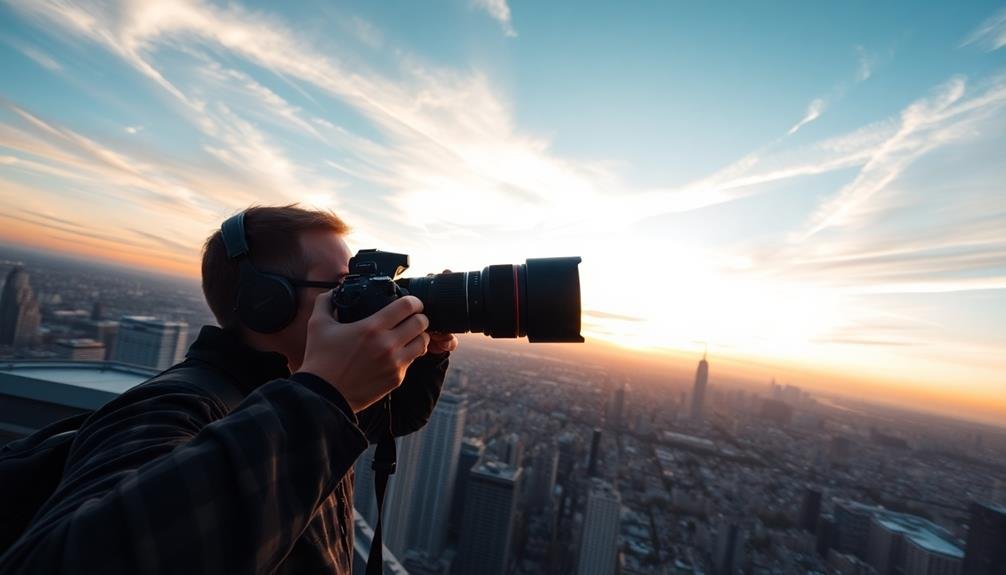
How can you capture the full breadth of a room in a single shot? A wide-angle camera lens is your answer. This essential tool allows you to showcase more of a property's interior and exterior spaces, giving potential buyers a thorough view of the real estate.
Wide-angle lenses typically have focal lengths between 14mm and 35mm, with 16-24mm being ideal for most real estate photography situations. They'll help you capture expansive living rooms, kitchens, and outdoor areas, making spaces appear larger and more inviting.
When using a wide-angle lens, be mindful of distortion. Straight lines near the edges of the frame may appear curved, so keep important architectural elements centered when possible. You'll also want to avoid placing objects too close to the lens, as this can create an unnatural perspective.
To maximize the benefits of your wide-angle lens, use a tripod for stability and shoot at a higher aperture (f/8 to f/11) to guarantee sharpness throughout the frame.
Experiment with different angles and heights to find the most flattering compositions for each space you're photographing.
Polarizing Filter
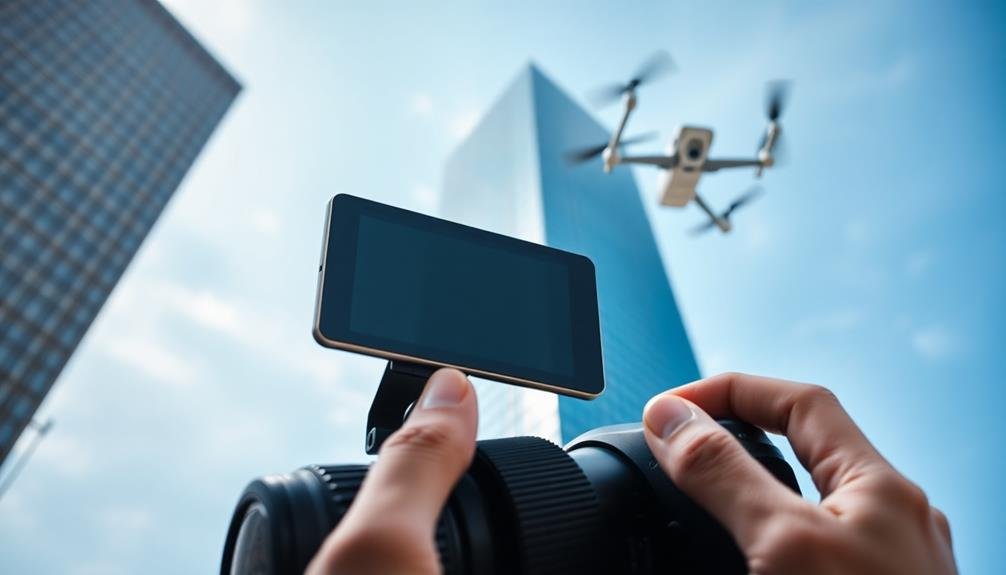
One of the most versatile tools in a real estate photographer's kit is the polarizing filter. This essential accessory can dramatically improve your real estate photos by reducing glare, enhancing colors, and increasing contrast.
When you're shooting exteriors, a polarizing filter will help you capture deep blue skies and vibrant green lawns. It'll also minimize reflections on windows, allowing you to showcase both the interior and exterior simultaneously.
For interior shots, the polarizing filter proves equally valuable. It'll reduce glare on shiny surfaces like hardwood floors, countertops, and appliances, revealing their true colors and textures.
You'll also find it useful for eliminating reflections on glass tables or mirrors, which can be distracting in your compositions.
To use a polarizing filter effectively, simply screw it onto your lens and rotate it while looking through the viewfinder. You'll see the effect change as you turn the filter.
Remote Controller
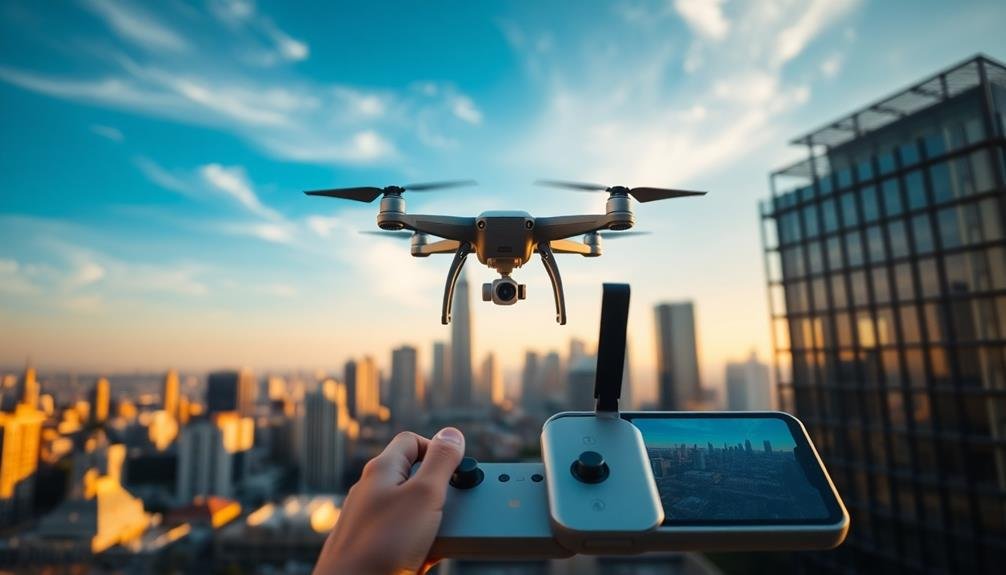
Enhancing your shooting flexibility, a remote controller is an indispensable tool for real estate photography. It allows you to trigger your camera from a distance, reducing camera shake and enabling you to capture shots from unique angles.
You'll find this particularly useful when photographing tight spaces or when you need to position yourself away from the camera to manage lighting or staging elements.
Many remote controllers offer advanced features beyond simple shutter release. You can adjust camera settings, control exposure bracketing, and even preview images on your smartphone or tablet.
This real-time feedback helps you fine-tune your shots without constantly returning to the camera.
When choosing a remote controller, consider compatibility with your camera model, range, and additional features like intervalometer functions for time-lapse photography.
Wireless options using Bluetooth or Wi-Fi provide greater freedom of movement, while wired controllers offer reliability in areas with potential signal interference.
Invest in a quality remote controller to streamline your workflow and improve the overall quality of your real estate photography.
It'll help you capture more professional, steady images and expand your creative possibilities in challenging shooting environments.
Portable Power Bank
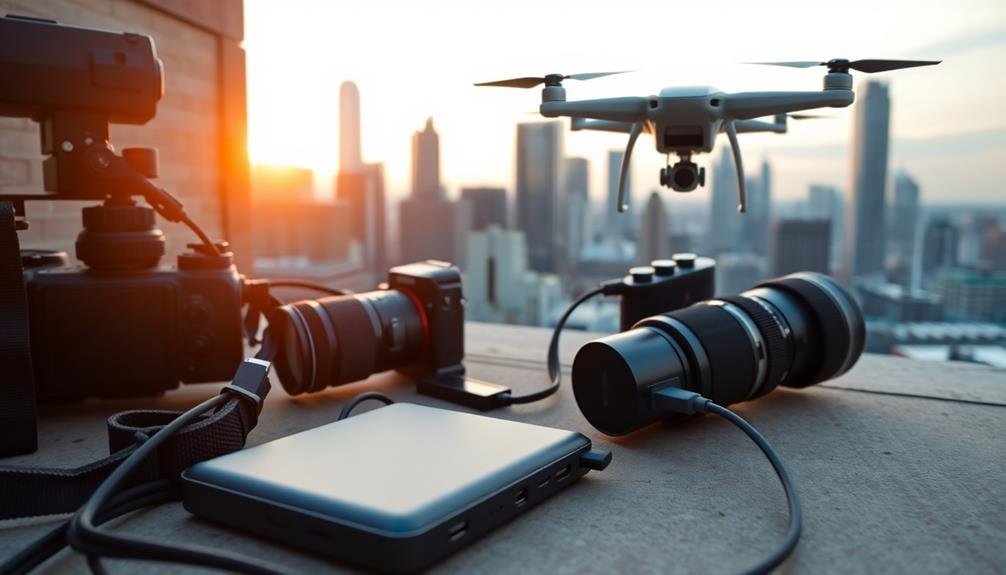
A photographer's worst nightmare is running out of battery power during an essential shoot. That's why a portable power bank is an indispensable tool for real estate photography.
You'll want to invest in a high-capacity power bank that can charge multiple devices simultaneously. Look for a power bank with at least 20,000mAh capacity, which can fully charge your camera, drone, and smartphone multiple times.
Opt for models with fast-charging capabilities and multiple output ports, including USB-A and USB-C. This versatility guarantees you can power various devices efficiently.
Consider the power bank's size and weight, as you'll be carrying it around properties. A compact, lightweight model is ideal for mobility. Some power banks even come with built-in cables, reducing the need for extra cords.
When choosing a power bank, check its compatibility with your specific equipment. Some high-end cameras and drones require more powerful output than standard USB ports provide.
In these cases, look for power banks with DC output options or specialized ports.
Memory Cards

Memory cards are the lifeblood of digital real estate photography. You'll need to invest in high-quality, reliable cards to guarantee you don't lose any of your valuable shots. Choose cards with fast read and write speeds to keep up with your camera's burst mode and high-resolution images.
When selecting memory cards, consider capacity and compatibility. For real estate photography, 32GB to 64GB cards usually suffice, allowing you to shoot an entire property without changing cards. Always check your camera's manual for compatible card types and maximum capacities.
It's wise to carry multiple cards rather than relying on a single high-capacity one. This strategy minimizes the risk of losing all your photos if a card fails. Additionally, invest in a protective case for your memory cards to shield them from dust, moisture, and physical damage.
Before each shoot, format your cards in-camera to guarantee peak performance. When you're done shooting, immediately back up your images to a separate device or cloud storage. This practice safeguards your work and allows you to reuse cards confidently for your next real estate photography assignment.
Editing Software
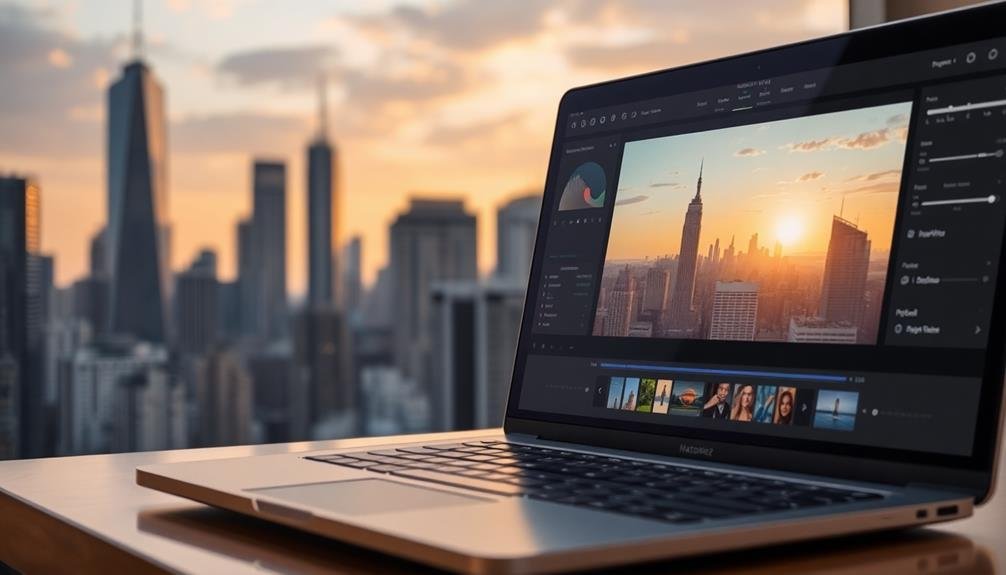
When it comes to real estate photography, your editing software can make or break your final images.
You'll want to explore popular options like Adobe Lightroom, Capture One, or Skylum Luminar, considering key features such as batch processing, HDR merging, and virtual staging capabilities.
To optimize your workflow, look for software that offers presets, customizable shortcuts, and seamless integration with your camera's raw files.
Popular Editing Software Options
For real estate photographers, editing software is just as essential as the camera itself.
You'll need a reliable program to enhance your images and create stunning visuals that attract potential buyers. Adobe Lightroom is a popular choice, offering powerful tools for color correction, exposure adjustment, and batch processing. Its user-friendly interface makes it ideal for both beginners and professionals.
Adobe Photoshop provides more advanced editing capabilities, allowing you to manipulate images with precision. It's perfect for removing unwanted objects, blending exposures, and creating composite images.
Capture One is another high-end option, known for its superior color grading and tethering capabilities.
For those on a budget, Affinity Photo offers a one-time purchase alternative with features comparable to Photoshop. Skylum Luminar AI is an excellent choice if you're looking for AI-powered editing tools that can save time and streamline your workflow.
DxO PhotoLab excels in noise reduction and lens correction, while ON1 Photo RAW combines photo organization with powerful editing tools.
Whichever software you choose, verify it meets your specific needs and enhances your real estate photography workflow.
Key Features to Consider
Now that you're familiar with various editing software options, it's important to understand the key features that can elevate your real estate photography.
Look for software that offers robust color correction tools, allowing you to adjust white balance, saturation, and vibrancy to showcase properties in their best light. Exposure adjustment capabilities are essential for balancing bright windows with darker interiors.
Consider programs with perspective correction features, which help straighten vertical lines and fix distortions common in wide-angle shots. HDR merging is another valuable tool, enabling you to combine multiple exposures for a well-balanced final image.
Lens correction features can address issues like vignetting and chromatic aberration. Seek software with efficient batch processing capabilities to streamline your workflow when dealing with multiple images.
Advanced retouching tools, such as object removal and sky replacement, can help you perfect your shots. Finally, don't overlook the importance of a user-friendly interface and compatibility with your existing hardware and workflow.
Workflow Optimization Techniques
Efficiency is key when it comes to editing real estate photos. To streamline your workflow, you'll need powerful editing software that can handle batch processing and advanced adjustments. Adobe Lightroom and Capture One are industry standards, offering robust tools for color correction, exposure balancing, and perspective adjustments.
Implement presets and actions to speed up repetitive tasks. Create a consistent look across your property portfolio by developing a signature style that you can apply with a single click. Don't forget to organize your files systematically, using keywords and metadata to make searching and sorting a breeze.
Here's a quick comparison of popular editing software options:
| Software | Pros | Cons |
|---|---|---|
| Adobe Lightroom | Extensive presets | Subscription-based |
| Capture One | Superior color editing | Steep learning curve |
| Luminar AI | AI-powered enhancements | Limited batch processing |
Remember to calibrate your monitor regularly to guarantee accurate color representation. Invest in a color-accurate display and consider using a colorimeter for precise adjustments. By optimizing your workflow, you'll save time and deliver consistently high-quality images that showcase properties in their best light.
Frequently Asked Questions
How Much Training Is Required to Operate a Drone for Real Estate Photography?
You'll need to complete a FAA-certified drone pilot course, which typically takes 15-20 hours. You must also pass the Part 107 exam and obtain a remote pilot certificate. Ongoing practice is essential to hone your skills.
Are There Specific Weather Conditions That Affect Sky-High Real Estate Photography?
You'll find weather greatly impacts sky-high real estate photography. Wind can destabilize your drone, while rain or snow can damage equipment. Bright sunlight causes harsh shadows, and cloudy days might diminish property appeal. Always check conditions before shooting.
What Insurance Considerations Should Real Estate Photographers Have for Drone Operations?
You'll need liability insurance to cover potential damages or injuries. Don't forget equipment insurance for your drone. Check if your existing policy covers aerial work, or consider specialized drone insurance for extensive protection.
How Do You Handle Privacy Concerns When Photographing Properties From Above?
You should respect privacy by avoiding capturing identifiable people or neighboring properties. Always obtain property owner consent, follow local regulations, and be transparent about your intentions. If you're unsure, it's best to consult legal advice before shooting.
What Are the Legal Restrictions for Flying Drones in Residential Areas?
You'll need to follow FAA regulations for flying drones in residential areas. Don't fly over people, stay below 400 feet, maintain visual line-of-sight, and respect privacy. Check local laws too, as they may have additional restrictions.
In Summary
You've now got the essential tools for stunning aerial real estate photography. With your high-quality drone, wide-angle lens, and polarizing filter, you're ready to capture breathtaking shots. Don't forget your remote controller and power bank to keep things running smoothly. Pack plenty of memory cards to store your masterpieces. Finally, invest in first-rate editing software to polish your images. You're all set to elevate your real estate photography game and impress clients with your sky-high shots.

As educators and advocates for responsible drone use, we’re committed to sharing our knowledge and expertise with aspiring aerial photographers.
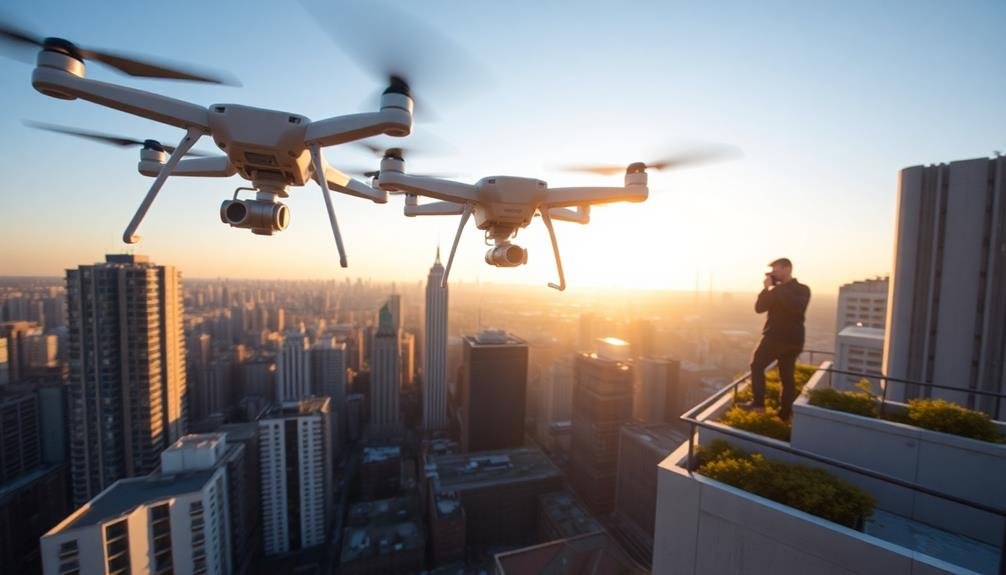



Leave a Reply